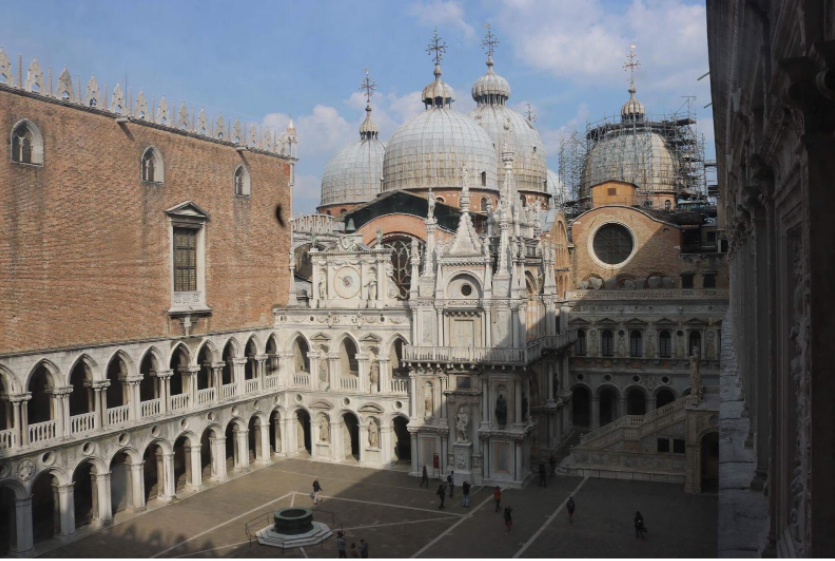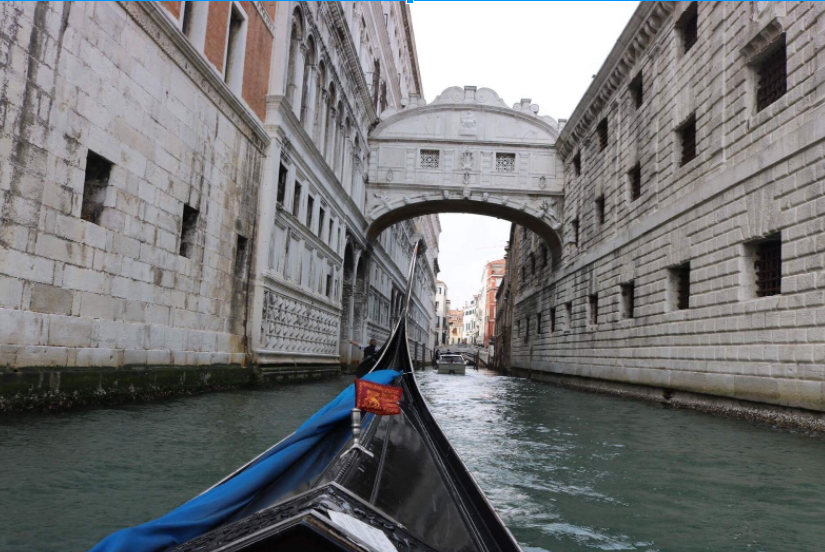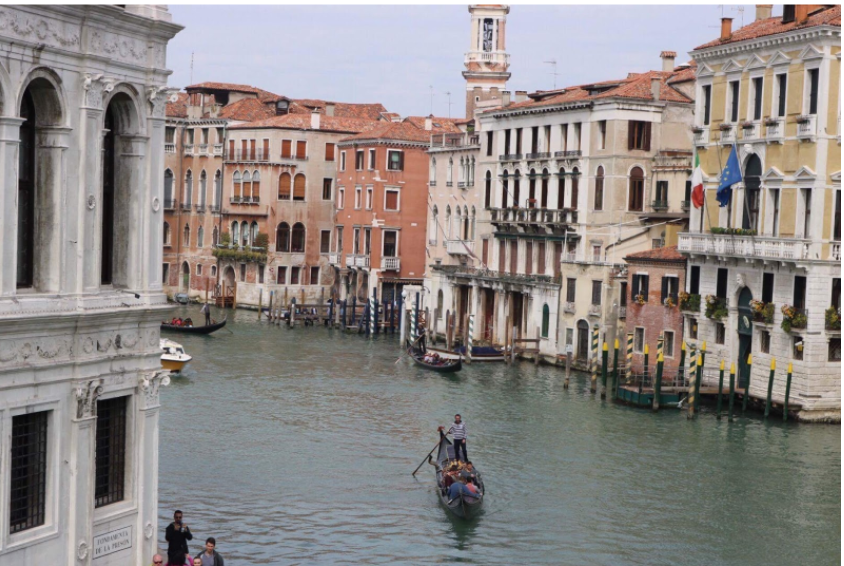I didn’t spend long in the Doge’s Palace. After three months of walking through these compounds, you realize how little you know about anything, and that not even a lifetime of studying a space can convey all that went on there. It’s a disservice to history, and I don’t bother. I exited the Palace into the northeastern corner of Piazza San Marco and couldn’t see anything past the crowds.
Along the port, the vaporettos were emptying, continuing to flood the Piazza. The cafés of Venice are not much different from the one’s I’ve loitered and chain-smoked at across Italy. I was warned to stay away from them anyway, especially around Piazza San Marco, but that’s all loose change is good for in this country; it certainly wasn’t going to the f*****g panhandlers. While passing a menu display, I saw my coordinator’s warning reiterated in price form: Twenty plus euro for one espresso. Impeccably-dressed Italian and English men and women were mannequin-ing in the café’s outside seating; cigars, rubies and all. I looked down to my fitted jeans, Michael Kors t-shirt and blazer combo which—in the States—whipped necks almost anywhere I went. Now, standing before this menu-turned-velvet-rope, I was adorned in rags. This waned as I spat and walked away and began strolling along the edge of the Grand Canal, juking out gypsies, tour guides, and American families blocking traffic. The edge ended, careening right, marked by the first window of Harry’s Bar. This is where all the wealth began. The streets started to narrow, and I heard more English being spoken. This was worse than Rome.
The group and I were hounded by waiters standing outside boat-rope-menu restaurants, each holding a corresponding amount of wine-lists in their hands. These f*****s watched us come up. We were always preyed on, but it’s nothing a powerwalk and dark sunglasses can’t fix. Finding nothing genuinely Venetian, or Italian for that matter, we ate at a Chinese restaurant. I didn’t realize we had paid too much money for a three course meal until later; each dish could’ve fit on one plate. They got us. I stepped out to smoke a cigarette, then walked over to a (practical) souvenir shop and bought the journal I drafted this essay on. Two days before arriving in Venice, I was at a café in Veneto. I picked up a newspaper, the front page was the same bridge I was about to cross, titled, “Trama bomba ponte di Rialto sventato” (Rialto Bridge bomb plot foiled). Barely missing Italy’s first terrorist attack doesn’t seem to bother the Venetians, or anyone else here. That’s if you can tell who’s who; there’s so many foreign bodies.
When I reached the crossroads of the Rialto, I, too, felt the Venetian apathy. I held back a smile at the thought of myself and the thousands of others on the Rialto Bridge conveying a ‘f*** you’ to those who failed at destroying the history and lives here. This was a different attitude than I saw Paris, whose plague of terrorist attacks has left the city perpetually neurotic. The group snapped pictures in front of the canal and jumped each time the vaporetto announced their arrival under the bridge via foghorn. Traffic of every kind was present, eventually becoming too much, leading me to a quiet corner near a souvenir stand where I waited for the rest of the group. It was a long, narrow walk back to Piazza San Marco. The space exploded in front of us and, from this angle (northwestern), I could see everything, even the corner where we started. We walked to the center and collected crumbs to feed the pigeons. A Japanese man in a wheelchair had birds lining his arms and a smile on his face; a French family took candid photos of each other while seed was being thrown in the air; a Muslim woman walked her son to a group of pigeons so he could touch them; us Hispanics spoke in Tex-Mex to each other, where it dissolved among several other languages. At least there’s one place in the world we can all run to.
I split from the rest of the group to find a place to write. Ernest Hemingway had frequented Harry’s Bar during his duck hunting trips in Venice, and I burned the location into memory after passing it earlier. Taking the same canal-edge walk as I did earlier with the group, now alone, felt different (better). I preferred to travel alone, and a solo trek to one of my favorite writer’s international haunts was my ideal way to spend an afternoon. I tried the door and was met with a concaved hall. I stepped in and went left, where the small bar opened before me. I’m assuming the trick hall is meant to confuse people with no intention of purchasing anything into thinking that the place is closed. I was greeted by a man who had a different suit on than the other servers and, being overwhelmed that I was actually there, fidgeted out that I wanted to sit at the bar in Italian. He offered me the far corner seat in English: where Hemingway sat. Nothing looks different from the pictures I’ve seen of the place. There’s hardly any decoration, either. There doesn’t seem to be any Italians here, only English.
Expensive bottles of liquor perched behind the bartender as he greeted me in French. I ordered a twenty-five euro old-fashioned, took out my journal and began writing. I hid in a blank page for more than five minutes before a man in Jordan shorts and a tank-top was asked to leave by a waiter in a spotless all-white double-breasted tuxedo. I drafted furiously once the man took his six-step walk of shame out into the windy alley he just came from, taking small sips from my drink every ten minutes. About an hour later, a married couple sat next to me. The wife said, “Okay, this is Harry’s!” They silently looked at their menus for a few moments, got up, and left. “Well, we at least got to see it,” she said as she passed me. I’m sure they were Hemingway readers, too; I would’ve enjoyed their company. I’ve finished my drink, but told the group I’d be here all afternoon before meeting them in the evening. But I couldn’t stay anymore. If I didn’t have a blazer on, or if they knew the fifty-euro note I held in my hand was the only cash I had to my name, I would’ve ended up like the others. I paid my tab and lit a cigarette at the register, blowing my first drag at the fake wall as I exited. “Sir! No puedes fumar aqui! Please!” I hopped a vaporetto back to Lido Island from the Piazza San Marco port and wrote the entire way, not bothering to look back at the hundreds of people that replaced my exit.

After napping at the hotel for a couple hours I went outside. The sun was close to setting, and everyone was out on their passeggiata. I merged into the traffic, looking for an ATM and a tabaccheria. Lido Island was calmer than Venice Island. The colors were all there, but it felt more crafted, suburban even. The roads and sidewalks were wide enough for two opposing flows of cars and people; and the cafes were very large, often extending onto the curb. Before I reached the end of the street, I noticed the haphazard use of English on advertisements, mixed with Italian and French words. I assume it’s another facet of Venetian culture: the people’s slow, painful assimilation into the globalized city that they don’t want. Foreign languages are placed with the same care as a pillow under the head of someone awaiting lethal injection: done so to not look apathetic, or, in this case, aren’t capable of adjusting to a growing economy, even if it means participating in their own cultural dissolution. The graffiti is a more honest expression of Venetian frustration. You see it all over the walls, condemning the Italian government or police, themselves, and especially tourists. These had to have been written by locals, but where does anyone live here? All the apartments look barren. Maybe that’s the point: to hide away once everyone’s played. The people that keep this city alive are hardly doing it for themselves. They’re in-residence staff for the millions of people that pass through, turning their city into the negative connotation of an attraction. I don’t blame the Venetians for being so frustrated; their city is f*****g sinking, and they have to fake-smile their way through the shift.
The air flows better here on Lido, thanks to the large streets. There was salt in it. The Venetians seemed a lot happier here than on Venice Island, but not by much. The group and I wandered, eventually reaching some docks by the Lido vaporetto port. From here we could see the entrance into the Grand Canal. Using port lights as distance markers, we could make out buildings on Venice Island. I looked out for a while, wondering how the Venetians do it: how they’re able to keep up this illusion with themselves for so damn long. Perhaps they have no choice, and it’s simply become too difficult to move on and start over, to painful to admit that the sacredness of Venice (as various graffiti around the islands proclaim it to be) is dissolving to globalization. The group and I went to a nearby bar and discussed these observations over several drinks, with the opinions getting more intense as the night went on. Once everyone went to bed, I walked out to the beach on the opposite end of the street. I went through the gated driveway of a beach house and vaulted the back wall, much like I did in high school after house parties on South Padre Island.
I removed my shoes and rolled up my pants, and continued the rest of the pilgrimage. The tide was low, and the sand was finely grained; it was a good beach. I saw lights from surrounding islands over the black water, where they met with the window and porch lights of the condos and beach houses that shot all the way down Lido. I belonged here, and only here. There was no place for a visitor in Venice, but there’s too many now. They buy the ticket and take the ride every day, utilizing this world-wide amusement park without realizing how much they’re not welcomed. After a few days of enduring this back and forth between exclusion and pseudo-inclusion, I was glad to have found home here. I sat for a while, then began to leave. I looked back here, where my eyes adjusted completely to the darkness, and looked at nothing in particular. I hope I didn’t stay too long.








